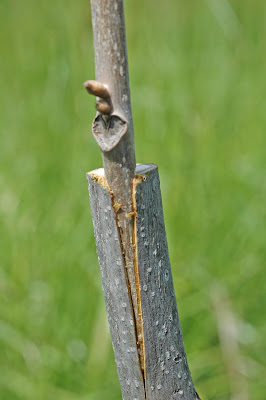This Spring has been great for grafting pecan trees. Trees broke bud with a bang about 3 weeks earlier that normal and ever since we've had moderate temperatures ideal for grafting success. Last weekend, I was out in the field grafting more Kanza trees and came across a tree too large for a 3-flap graft but too small for a bark graft (photo at right). Sure, I could have placed a 3-flap graft up near the top of the tree. But, to make sure my graft will get a good push from the root system, I like to remove at least one-half of the top when choosing a spot to graft.
In the photo at left, I'm holding my scion next to the location on the tree I intend to apply the graft. The trunk of the tree in this photo is about 3/4 inch in diameter, while my scion is about 3/8 inch in thickness. In this situation, I use a grafting technique that is known as the arrowhead graft. This method is actually a modification of the bark graft developed specifically for small diameter trees (0.75 to 1.5 inches in dia.) with smooth, thin bark.
To prepare the stock for grafting, I use the tip of my knife to slice through the bark in a straight line down the stem about 3 inches long.
Next, I turn my attention to carving the scion. Using my grafting knife, I make a deep cut into the scion leaving a thin, tapered tongue with a curved shoulder at the top (photo at left).
I turn the scion to look at the bark side of the tongue. Starting just below the shoulder, I remove some of the bark along the edge to expose cambium. I make sure I see white wood all along the edge to ensure I have cambium exposed the entire length of the scion.
Next, I move to the other edge of the scion and make another cut exactly like the first. In the end, it should look like you a sharpening an arrowhead (photo at left). I make sure to leave a strip of bark down the center of the scion that comes to a point at the end.
The last cut I make is simply to put a chisel point on the scion to make it easier to slip the scion under the bark if the stock (photo at right).
Now that the scion is completely carved, I insert it under the bark of the stock right down the center of the incision made previously (photo at left). As I push the scion down, I make sure that it lifts the bark on both sides of the incision.
I drive the scion all the way down until the scion's shoulder touches the top of the stock. Note that you can see the strip of bark I left on the back of the scion and that both edge cuts are now covered by bark flaps.
For any grafting technique to work, the cambium of the scion must be tightly fit against the cambium of the stock. But, look how the scion has pulled the bark away from the stock and left gaping holes (photo at left). I'll use my staple gun to snug things up and conform the bark of the stock tight against the scion.
Starting at the bottom of the graft, I use a light duty staple gun (Arrow model JT-21) to shoot 5/16 inch staples into the bark of the stock just outside the edge of the scion. The staples bend the bark inwards, pressing it up against the cut surface (and cambium) of the scion. I alternate sides as I place the staples so the scion won't slide to one side or the other. Six staples usually does the trick.
Now look at the graft from above (photo at left). After stapling, the bark of the stock sits firmly against the scion.
With staples placed only through the stock's bark, this graft is weakly attached at this point. So, to secure the scion in place, I wrap the scion with grafting tape (photo at right). Note that I covered the entire graft union with tape, including the upper edge of the stock.
This graft receives the same protective covers I used in the 3-flap and bark graft. I wrap aluminum foil over the graft union then place a sandwich bag over the graft as well.
I grafted this tree in an area that deer frequent. So, instead of my normally applied bird perch, I placed a 2 foot diameter deer cage over the graft (photo at left). The cage is constructed of 2" x 4" welded wire that is 5 feet tall and secured with a steel fence post. These cages not only keep curious deer away from my graft, the birds will perch on the cage and not the graft.
Here's a photo of a successful arrowhead graft (at right). You can see that the scion has grown rapidly, popping out from under the bark flaps of the stock. The staples are still there but the tree has grown over them.














